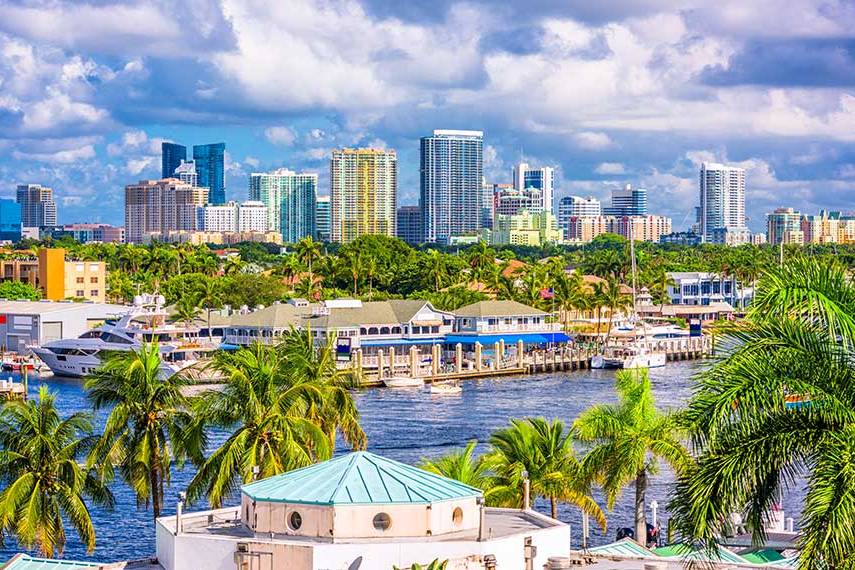Real Estate Investment Funds (FIIs) and investing in real estate in Florida represent two options attractive to investors who want to benefit from the real estate sector. Each of these alternatives offers different characteristics in terms of profitability, diversification, risks and accessibility. In Brazil, FIIs have gained popularity due to their accessibility and the possibility of diversification, while buying real estate in the United States attracts investors due to its profitability, economic stability and currency protection.
Contents
HideTo understand the historical appreciation of Real Estate Funds in Brazil and compare them to real estate in Florida, it is essential to understand the index IFIX (Index of Real Estate Investment Funds). The IFIX is an indicator of the performance of the main Real Estate Funds traded on the Brazilian Stock Exchange, B3. Just as the Ibovespa measures the general performance of shares, the IFIX reflects the variation in prices and the profitability generated by FII dividends over time.
Over the last 10 years, the IFIX has seen an accumulated appreciation of 102,67%which represents the average performance of the FII market in Brazil. This valuation includes both asset appreciation and distributed income, which is a hallmark of these funds since, by law, Brazilian FIIs must distribute 95% of their profits to shareholders.
On the other hand, real estate in Florida has seen an accumulated appreciation of 136,74% in the same period, in dollars. This performance reflects the growth of the American real estate marketThis is driven by factors such as high residential demand, low unemployment levels and attractive interest rates. Florida, in particular, has benefited from a continuous influx of new residents, especially from other American states, and an increase in foreign investors, including Brazilians.
This comparison highlights important differences in profitability between the two markets, but it is also essential to consider other factors, such as associated risks, diversification and costs, which will be covered in the following topics.
To make our analysis even more complete, we can add to the debate American real estate funds, known as REITS. These assets are comparable to Brazilian Real Estate Funds, allowing participation in real estate developments without the need to acquire or manage a property directly.
Over the last 10 years, REITs, as measured by the FTSE Nareit All Equity REITs Indexhad an accumulated historical return of 68,2%. Even though the performance is lower than that of Brazilian real estate funds, later in this article we will explore the real returns of each of the assets, adjusting them for inflation. In addition, exposure to the American market is also beneficial for this asset class, which allows for diversification in the US, with specialized segments such as corporate buildings, residential, hotels, health centers and even data centers.
Inflation plays a central role in the deterioration of the purchasing power of currencies and consequently affects the profitability of your investments. In the last 10 years, Brazil has accumulated inflation of 77%while in the United States this index was only 33%. This disparity already indicates a significant difference in the impact that each market has on the purchasing power of its investors.
The Risks of High Inflation
In Brazil, high inflation directly affects the real value of income, eroding purchasing power over time. Investors who fail to beat inflation with their returns effectively lose moneyeven if the nominal figures seem high. Investors lose purchasing power. In addition, periods of high inflation are usually accompanied by economic instability, rising interest rates and reduced investor confidence, resulting in an unfavorable investment environment.
In the United States, controlled inflation of 33% over the same period represents a more stable and predictable scenario for investors. Although inflation also affects purchasing power, the impact is much less, and economic policy measures are generally more effective in protecting the economy.
Being exposed to a market with high inflation directly influences the real profitability of your investments.
As well as affecting purchasing power, high inflation can damage the confidence of foreign investors, increase the cost of capital and generate economic instability, making Brazil a less predictable market. On the other hand, moderate and controlled inflation in the United States offers a more favorable environment for preserving and increasing investors' purchasing power.

What is real profitability?
Real profitability is an essential concept in the investment world, because it measures the effective return on an investment after discounting the effects of inflation. In simple terms, while nominal profitability shows the gross growth of an investment, real profitability shows how much of this growth translates into an effective gain in purchasing power.
Considering the real profitability of investments is essential because it reflects the real gain or loss of purchasing power over time, adjusted for inflation. While the nominal return may show an apparently attractive figure, it doesn't take into account the impact of inflation, which erodes the real value of money. In high inflation scenarios, such as in Brazil, this can mean that a nominally profitable investment has actually generated real losses.
In the context of Brazil and the United States, where historical inflation has marked differences, analyzing real returns offers a clear perspective on the risks and benefits of investing in each market.
To calculate the real return, it is necessary to adjust the nominal investment returns for the impact of inflation. The formula used is as follows:
RR = (1+nominal profitability / 1+inflation)-1
This formula takes into account the fact that inflation reduces the purchasing power of the returns obtained, adjusting the nominal gain to reflect the real increase in assets.
Let's apply the formula to the Brazilian and American scenarios:
FIIs Brazil simulation:
- Nominal profitability of FIIs (2015-2025): 102.67%
- Accumulated inflation (2015-2025): 77%
RR = (1+1.0267)/1+0.77)-1
RR = (2.0267/1.77)-1
Real Profitability = 14%
Florida Property Simulation:
- Nominal return on real estate (2015-2025): 136.74%
- Accumulated inflation (2015-2025): 33%
RR = (1+1.3674/1+0.33)-1
RR = (2.3674/1.33)-1
Real Profitability = 78%
REIT simulation:
- Nominal return on REITs (2015-2025): 68.2%
- Accumulated inflation (2015-2025): 33%
RR = (1+0.682/1+0.33)-1
RR = (1.682/1.33)-1
RR = 26.4%

In Brazil, the impact of high inflation significantly reduces the real profitability of FIIs, resulting in a gain of only 14% over 10 years. In the United States, moderate inflation means that the real return still remains considerably attractive, even if it is lower than the nominal return. Investment in real estate in Florida shows a real return of 78%. REITs, on the other hand, even though their nominal return was lower than that of FIIs during the period, demonstrate the power of inflation to erode returns. In the simulated case, the real return on REITs is around 26%, while FIIs show a return of only 14%.
Real profitability considering the exchange rate
Exchange rate fluctuations are also a crucial factor when evaluating investments between countries. Since the creation of the real in 1994, the Brazilian currency has lost 83% of its value against the dollar. However, if we only consider the exchange rate variation from January 2015 (US$1 = R$2.6) to January 2025 (US$1 = R$6), the impact on purchasing power is obvious. For this simulation, let's take as a base an initial investment of 400,000 dollars:
Simulation:
Impacto Imóveis Florida:
Initial value: $400,000 (converted to reais in 2015: R$1,040,000)
Return on real estate in Florida: 136.74% in dollars
New dollar value after 10 years: $947,000 (136.74% of $400,000)
Conversion to reais today: $947,000 x R$6.00 = R$5,682,000
Impact of REITs:
Initial Value: $400,000 (Converted to Reais in 2015: R$1,040,000).
REITs profitability: 68.2% in dollars.
New dollar value after 10 years: $673,000
Conversion to reais today: $673,000 x R$6.00 = R$4,036,800.00.
Impact of FIIs in Brazil:
Return in reais of FIIs: 102.67% on R$1,040,000 ($400,000 in 2015) = R$2,107,568 in 2025.
The US property not only protected the investor from local inflation, but also provided a substantial gain due to the appreciation of the exchange rate and the property itself. Meanwhile, investments in REITs, although profitable, have not seen the same magnitude of appreciation. FIIs, on the other hand, suffer even more, as they don't take advantage of the profitability brought about by exchange rate variations.
Being exposed to the Brazilian or American markets means that the performance of your investment will be directly related to the economic, political and social conditions in those countries. In Brazil, factors such as political instability, high inflation and currency fluctuations often negatively affect investments. In the United States, the world's most robust and diversified economy, stability is a significant differentiator.
Exchange rate risk is another critical point to consider. Since its creation in 1994, the real has lost 83% of its value against the dollarThis demonstrates the trend towards a sharp devaluation of investments in Real compared to the Dollar. On the other hand, investing in real estate in Florida means protecting your capital in a strong currency, which is appreciating more and more against the Real and is widely accepted globally.
Another important aspect to consider is the ability of economies to recover in times of crisis. The United States has historically led the recovery in global crises, due to its financial strength, the diversity of economic sectors and the central role of the dollar in world trade. Brazil, on the other hand, tends to suffer more deeply and take longer to recover.
In a global crisis scenario, where do you think your capital would be safer: in an unstable and vulnerable economy like Brazil's or in the world's largest economy, the United States?
Taxation is a crucial factor in investment analysis, as it has a direct impact on net profitability. Recently, tax reform in Brazil brought significant changes for Real Estate Investment Funds (FIIs), while in the United States, taxation on real estate follows different rules.
Taxation of FIIs in Brazil
With the enactment of the tax reform in January 2025, FIIs became subject to the Contribution on Goods and Services (CBS) and the Tax on Goods and Services (IBS). Previously, FIIs were not subject to these taxes, which gave them a tax advantage. Although dividends distributed to shareholders remain exempt from income tax for individuals, the new taxation on fund operations could reduce investors' net returns.
Property Taxation in Florida
In the United States, taxation on real estate mainly involves:
- Property Tax: levied annually by local governments, it varies according to the assessed value of the property and the rate determined by the county or municipality.
- Capital Gains Tax: Applied to the profit on the sale of the property. For properties held for more than one year, the rates vary from 0% to 20%, depending on the taxpayer's income bracket.
- Rental Income Tax: Rental income is subject to federal income tax, with progressive rates starting at 10%.
Foreign investors, including Brazilians, are subject to the same tax rules, but should consider international treaties that may influence taxation and avoid double taxation.
Diversification
One of the biggest advantages of Real Estate Investment Funds (FIIs) and REITs over direct investment in real estate is the possibility of diversifying in a more efficient and accessible way. By investing in FIIs or REITs, the investor is automatically exposed to a diversified portfolio of properties, which can include shopping centers, offices, logistics warehouses and even hospitals. This diversification helps to dilute the risks associated with specific market fluctuations, such as problems in a single property or sector. On the other hand, when investing directly in real estate, capital is usually allocated to one or two assets, increasing the concentration of risk.
Initial Capital
Another important point is the initial capital required. Buying a property, especially in appreciating markets like Florida, requires a significant investment, often in excess of hundreds of thousands of dollars. FIIs, on the other hand, allow investors to start with much lower amounts, making them accessible to small investors wishing to enter the real estate market. This accessibility democratizes investment, allowing more people to participate in the profits generated by the sector, with low initial values.
Liquidity
In addition, FIIs and REITs offer greater liquidity than real estate. While selling a property can take a few months, FII shares can be bought and sold quickly on the stock exchange, making it easier to adjust the investment portfolio as needed.
| Pros and cons | FIIs | Florida |
| Profitability | 102% | 136% |
| Inflation (Country) | 77% (Brazil) | 33% (USA) |
| Real Profitability | 14% | 78% |
| Asset liquidity | High | Low |
| Initial Capital Required | Bass | High |
| Diversification | High | Low |
| Exchange protection | ⛔ | ✅ |
Finally, it is important to note that the decision between investing in FIIs or real estate must take into account the personal objectives, investment horizon and risk profile of each investor. While FIIs or REITs are ideal for those looking for diversification, practicality and lower initial capital, the direct purchase of real estate may be more suitable for those who prioritize direct control over the asset, seek security in stable markets such as the United States and prioritize higher returns on investment. Regardless of the choice, aligning your willingness to take risks with your financial objectives is essential for making well-informed investment decisions.
Real estate investment in Florida is becoming increasingly attractive to Brazilians looking for good returns and asset protection. After all, being exposed to the dollar, especially at times of economic and political uncertainty, reassures investors, who are now able to invest in a low-risk asset class with attractive returns.
- More Return - IFIX
- RICO - Inflation Brazil
- FED - US inflation
- Poder 360 - Dollar appreciation
- FTSE Nareit All Equity REITs Index - Reits
Did you like the article? Keep an eye on our blog! Looking to live or invest in real estate in Florida? Check out the list of houses for sale in Florida that we've selected for you!






